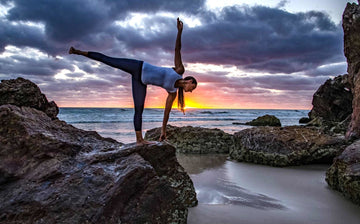
There is nothing worse than turning up to a yoga class and feeling completely unco‚ and self-conscious. Choosing the right type of yoga to suit your individual body, needs and physical ability, as well as understanding some of the foundations of yoga is the key to blissful success.
A pain in the Asana?
Randomly turning up to any yoga class for a beginner yogi or yogini is unfortunately a mistake I quite often see many individuals make. Some people swear they would forever stay away from yoga purely because they had a bad experience at a class that was simply too advanced for them. If you have never participated in yoga before, your best choice would be trying a beginners class. Beginner classes are just that little bit slower, as they explore the basic yoga poses. The teacher will take more time to set up the asana (yoga pose) and adjust students when needed so that the practice is safe. If a beginner class is not available, try a general yoga class but make sure you inform the teacher you are a new participant, and of course, also let them know of any injuries you may have so they can assist you during the class by giving you more simple options to follow or props such as a yoga block or strap to use. Sometimes you'll finish the class thinking it was actually ok, but you really didn't connect with the teacher. That's perfectly normal too. There will be a teacher that resonates for you.
Yoga to suit every - body
If you want to get a great workout while practicing and getting the benefits of yoga, you might like to try Yoga Flow, Vinyasa or power yoga classes. These classes are more dynamic than the average yoga class. Vinyasa or flow classes will get your heart rate up as well as tone and stretch you beautifully, while power yoga will focus more on strength and core.
If you are after a more relaxed yoga class, especially if your stress levels are through the roof, try Restorative Yoga or a Yin Yoga class. Both these classes are very slow, where you hold different (mostly stretchy) poses for a long time, and learn to focus on your breath as you enter a semi meditative state.
Did you know?
- One of the translations to the Sanskrit word 'Asana', which relates to yoga poses, is 'a comfortable seat'. One of the reasons yoga asanas were created thousands of years ago was as preparation for meditation - to simply get the body to become relaxed enough so that the Yogi could sit comfortably (or lie in Savasana) for long periods of time in order to meditate.
- True Yogis and Yoginis are vegetarians following a diet which excludes meat and eggs known as the 'Sattvic Diet', Sattva in Sanskrit means goodness, calm and clear. Sattvic living promotes purity and a more contented existence. The yogis believe consuming mostly unprocessed, natural, vegetarian food promotes a peaceful state for the body and mind, while consuming meat, alcohol and processed foods deplete the body of Prana (energy) and can lead to dark emotions such as anger and greed. A Sattvic diet combined with regular yoga asana and meditation practice according to Yogic belief will lead to a purer, higher sense of living or bliss, also known as Samadhi.
- The yoga we get to practice when we participate in a yoga class, the physical aspect of yoga that is, is generally only one aspect of this wholistic discipline. There are another 7 limbs of yoga which many of us are generally unaware of. The limbs include within them a set of 'Yamas' and 'Niyamas', which represent ethical and moral principles we should live in as individuals and as a society. So really, yoga as a whole resembles a set of instructions for us to live the healthiest and most spiritual lives we all deserve as equal human beings. It does not conflict with any religion, but helps promote spiritualism for those who follow a religious path of any kind, while also helping find a deeper connection with 'self' for those who don't.
- Whenever you are feeling stressed or anxious, practicing just 5 minutes of 'Nadi Shodhana' Pranyama (Breath regulation) can help turn down your internal speedometer and help you calm down. Try this:
- Place the left hand in Gyan Mudra resting on the left knee, tip of the thumb and tip of the index finger together.
- Place the tips of the index and middle finger of the right hand to the eyebrow centre, with the ring finger resting lightly on the left side of the nose and the thumb resting lightly on the right side.
- Start by exhaling from both sides.
- Gently close the left side with your ring finger, exhale slowly through the right side. Pause briefly.
- Inhale slowly through your right side. Pause briefly.
- Open the left side first, then gently close the right side with your thumb, and exhale slowly through your left side. Pause briefly.
- Gently inhale through your left side. Pause briefly.
- Open the right side then gently close the left side with your ring finger and exhale through the right side. Pause briefly.
- Continue as instructed for as many breath cycles you are comfortable with.
(The extensive meaning of the word Namaste widely used is yoga)
"I honour the place within you which is also within me. I honour the place within you which is of love, of truth, of light and of peace. When you are in your place, and I am in mine, we are one."
Namaste



